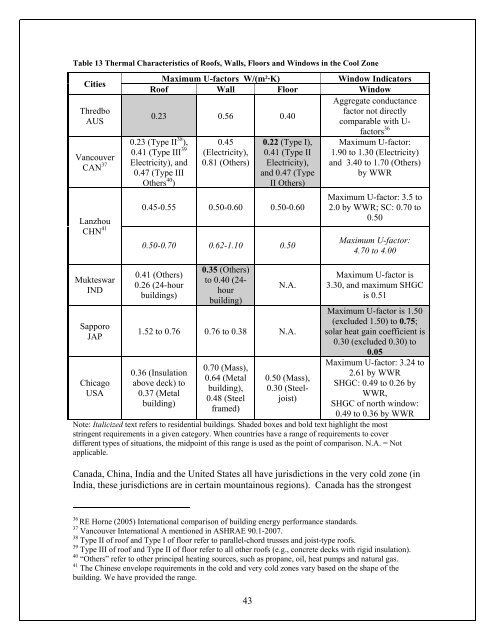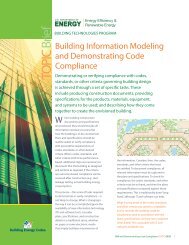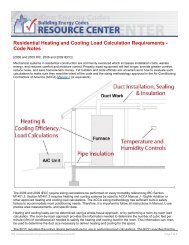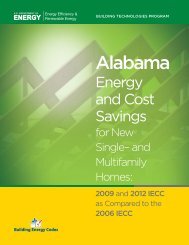Shaping the Energy Efficiency in New Buildings - Building Energy ...
Shaping the Energy Efficiency in New Buildings - Building Energy ...
Shaping the Energy Efficiency in New Buildings - Building Energy ...
Create successful ePaper yourself
Turn your PDF publications into a flip-book with our unique Google optimized e-Paper software.
Table 13 Thermal Characteristics of Roofs, Walls, Floors and W<strong>in</strong>dows <strong>in</strong> <strong>the</strong> Cool ZoneCitiesMaximum U-factors W/(m²·K)W<strong>in</strong>dow IndicatorsRoof Wall Floor W<strong>in</strong>dowAggregate conductanceThredbofactor not directly0.23 0.56 0.40AUScomparable with U-factors 360.41 (Type III 39 (Electricity), 0.41 (Type II 1.90 to 1.30 (Electricity)VancouverCAN 37 Electricity), and 0.81 (O<strong>the</strong>rs) Electricity), and 3.40 to 1.70 (O<strong>the</strong>rs)0.47 (Type IIIand 0.47 (Type by WWR0.23 (Type II 38 ), 0.45 0.22 (Type I), Maximum U-factor:O<strong>the</strong>rs 40 )II O<strong>the</strong>rs)0.45-0.55 0.50-0.60 0.50-0.60LanzhouMukteswarINDSapporoJAPChicagoUSA0.50-0.70 0.62-1.10 0.500.41 (O<strong>the</strong>rs)0.26 (24-hourbuild<strong>in</strong>gs)0.35 (O<strong>the</strong>rs)to 0.40 (24-hourbuild<strong>in</strong>g)N.A.1.52 to 0.76 0.76 to 0.38 N.A.0.36 (Insulationabove deck) to0.37 (Metalbuild<strong>in</strong>g)0.70 (Mass),0.64 (Metalbuild<strong>in</strong>g),0.48 (Steelframed)0.50 (Mass),0.30 (Steeljoist)Maximum U-factor: 3.5 to2.0 by WWR; SC: 0.70 to0.50Maximum U-factor:4.70 to 4.00Maximum U-factor is3.30, and maximum SHGCis 0.51Maximum U-factor is 1.50(excluded 1.50) to 0.75;solar heat ga<strong>in</strong> coefficient is0.30 (excluded 0.30) to0.05Maximum U-factor: 3.24 to2.61 by WWRSHGC: 0.49 to 0.26 byWWR,SHGC of north w<strong>in</strong>dow:0.49 to 0.36 by WWRNote: Italicized text refers to residential build<strong>in</strong>gs. Shaded boxes and bold text highlight <strong>the</strong> moststr<strong>in</strong>gent requirements <strong>in</strong> a given category. When countries have a range of requirements to coverdifferent types of situations, <strong>the</strong> midpo<strong>in</strong>t of this range is used as <strong>the</strong> po<strong>in</strong>t of comparison. N.A. = Notapplicable.Canada, Ch<strong>in</strong>a, India and <strong>the</strong> United States all have jurisdictions <strong>in</strong> <strong>the</strong> very cold zone (<strong>in</strong>India, <strong>the</strong>se jurisdictions are <strong>in</strong> certa<strong>in</strong> mounta<strong>in</strong>ous regions). Canada has <strong>the</strong> strongest36RE Horne (2005) International comparison of build<strong>in</strong>g energy performance standards.37 Vancouver International A mentioned <strong>in</strong> ASHRAE 90.1-2007.38 Type II of roof and Type I of floor refer to parallel-chord trusses and joist-type roofs.39 Type III of roof and Type II of floor refer to all o<strong>the</strong>r roofs (e.g., concrete decks with rigid <strong>in</strong>sulation).40 “O<strong>the</strong>rs” refer to o<strong>the</strong>r pr<strong>in</strong>cipal heat<strong>in</strong>g sources, such as propane, oil, heat pumps and natural gas.41 The Ch<strong>in</strong>ese envelope requirements <strong>in</strong> <strong>the</strong> cold and very cold zones vary based on <strong>the</strong> shape of <strong>the</strong>build<strong>in</strong>g. We have provided <strong>the</strong> range.43
















